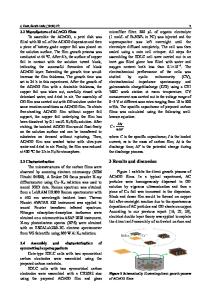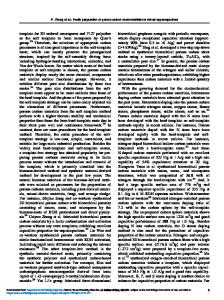Improved specific capacitance of pitch-based activated carbon by KOH/KMnO 4 agent for supercapacitors
- PDF / 2,249,419 Bytes
- 7 Pages / 595.276 x 790.866 pts Page_size
- 71 Downloads / 373 Views
Carbon Letters https://doi.org/10.1007/s42823-020-00158-6
RAPID COMMUNICATIONS
Improved specific capacitance of pitch‑based activated carbon by KOH/KMnO4 agent for supercapacitors Sang Jin Kim1,2 · Byong Chol Bai3 · Min Il Kim4 · Young‑Seak Lee1,5 Received: 10 April 2020 / Revised: 22 April 2020 / Accepted: 31 May 2020 © Korean Carbon Society 2020
Abstract The pitch-based activated carbons were prepared with KOH/KMnO4 as a multiple function activation agent to increase the specific capacitance of a supercapacitor electrode active material. And the porous structure and electrochemical properties of activated carbon were analyzed on varying amounts of K MnO4. KMnO4 was decomposed into K 2O, MnO, and O 2 at the activation temperature of KOH, and MnO was introduced to activated carbon. K 2O/O2 reacts with a surrounding pitch to generate micropores and forms a pathway that exposes MnO to the outside. It also affects to the specific surface area of activated carbon like KOH chemical activation. The enhanced specific surface area and introduced MnO in activated carbon led to a 28.9% increase in specific capacitance. Keywords Pitch · Activated carbon · KMnO4 · MnO · Supercapacitor · Specific capacitance Activated carbon is a common electrode material of EDLCs (Electrostatic double-layer capacitors) because of its outstanding adsorption/desorption performance and conductivity. As a porous carbon material with high specific surface area, it contains pores for the adsorption and desorption of ions. Many studies have focused on overcoming the low energy density of EDLCs by enhancing electrochemical properties such as specific capacitance and output. In particular, the two main approaches are: (1) increasing the total * Byong Chol Bai [email protected] * Young‑Seak Lee [email protected] 1
Department of Chemical Engineering and Applied Chemistry, Chungnam National University, Daejeon 34134, Republic of Korea
2
Gyeongbuk Science and Technology Promotion Center, Gumi Electronics and information technology research institute (GERI), Gumi 39171, Republic of Korea
3
Strategic Planning Division, Korea Institute of Convergence Textile, Iksan 54588, Republic of Korea
4
Carbon Industry Frontier Research Center, Korea Research Institute of Chemical Technology (KRICT), Daejeon 34114, Republic of Korea
5
Institute of Carbon Fusion Technology (InCFT), Chungnam National University, Daejeon 34134, Republic of Korea
pore volume and specific surface area to enhance the adsorption capacity of ions [1–3], and (2) adding surface functional groups or metal oxides to activated carbon to enhance the electrochemical properties of electrode materials [4–6]. Manganese oxide (MnxOy), which is abundant is nature and has low toxicity, is widely used as a material for electrodes. In particular, manganese monoxide (MnO) has the highest theoretical specific capacitance among manganese oxides (1360 F/g) [7, 8]. However, this material is difficult to utilize because of its poor cycle stability and conductivity. Thus, Mn
Data Loading...











